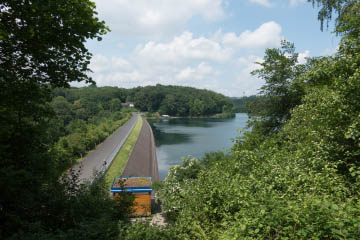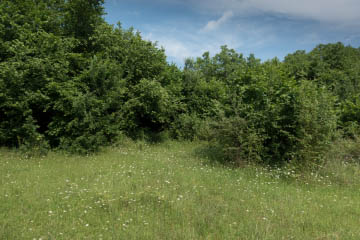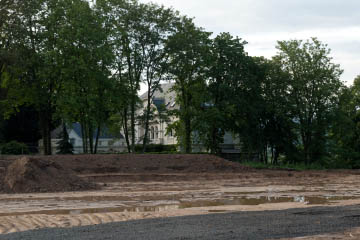Bonn,  GermanyBonn is home to 48 species of the 177 butterfly species currently occurring in
GermanyBonn is home to 48 species of the 177 butterfly species currently occurring in  Germany
Germany Germany. This is 27 per cent.
Germany. This is 27 per cent.
However, this number was much higher not so long ago: 35 species are now extinct in Bonn,  GermanyBonn, so there were once 83 species, ocurring in Bonn,
GermanyBonn, so there were once 83 species, ocurring in Bonn,  GermanyBonn. As a result, Bonn,
GermanyBonn. As a result, Bonn,  GermanyBonn has lost 42 per cent of its butterfly species.
GermanyBonn has lost 42 per cent of its butterfly species.
It is pleasing that I was able to photograph 4 species in Bonn,  GermanyBonn that are not listed in Reinhardt; Harpke; Caspari; Dolek; Kuehn; Musche; Trusch; Wiemers; Settele, 2020 - Verbreitungsatlas der Tagfalter und Widderchen DeutschlandsReinhardt; Harpke; Caspari; Dolek; Kuehn; Musche; Trusch; Wiemers; Settele, 2020 - Verbreitungsatlas der Tagfalter und Widderchen Deutschlands as occurring in Bonn,
GermanyBonn that are not listed in Reinhardt; Harpke; Caspari; Dolek; Kuehn; Musche; Trusch; Wiemers; Settele, 2020 - Verbreitungsatlas der Tagfalter und Widderchen DeutschlandsReinhardt; Harpke; Caspari; Dolek; Kuehn; Musche; Trusch; Wiemers; Settele, 2020 - Verbreitungsatlas der Tagfalter und Widderchen Deutschlands as occurring in Bonn,  GermanyBonn:
GermanyBonn:
 Lesser Purple EmperorApatura ilia (Denis & Schiffermüller, 1775)
Lesser Purple EmperorApatura ilia (Denis & Schiffermüller, 1775) Lesser Purple Emperor
Lesser Purple Emperor Brown ArgusAricia agestis (Denis & Schiffermüller, 1775)Polyommatus agestis
Brown ArgusAricia agestis (Denis & Schiffermüller, 1775)Polyommatus agestis Brown Argus
Brown Argus Marbled FritillaryBrenthis daphne (Denis & Schiffermüller, 1775)
Marbled FritillaryBrenthis daphne (Denis & Schiffermüller, 1775) Marbled Fritillary
Marbled Fritillary Mallow SkipperCarcharodus alceae (Esper, 1780)
Mallow SkipperCarcharodus alceae (Esper, 1780) Mallow Skipper
Mallow Skipper
By the way: in my youth I saw a  Compton Tortoise ShellNymphalis vaualbum (Denis & Schiffermüller, 1775)Nymphalis l-albumPolygonia vau-albumVanessa l-albumPolygonia l-albumRoddia l-albumRoddia vaualbumRoddia v-albumRoddia j-albumCompton TortoiseshellFalse CommaCompton Tortoise Shell in Bonn-Kessenich on 11 March 1990, an eastern species that does not actually occur in the Rhineland.
Compton Tortoise ShellNymphalis vaualbum (Denis & Schiffermüller, 1775)Nymphalis l-albumPolygonia vau-albumVanessa l-albumPolygonia l-albumRoddia l-albumRoddia vaualbumRoddia v-albumRoddia j-albumCompton TortoiseshellFalse CommaCompton Tortoise Shell in Bonn-Kessenich on 11 March 1990, an eastern species that does not actually occur in the Rhineland.
The following list shows the species that occur in Bonn,  GermanyBonn and those that are extinct or missing.
GermanyBonn and those that are extinct or missing.
 (occurring) indicates species occurring after the year 2000.
(occurring) indicates species occurring after the year 2000.
 (extinct) indicates species that occurred in Bonn,
(extinct) indicates species that occurred in Bonn,  GermanyBonn between the year 1900 and 2000, but no longer after 2000.
GermanyBonn between the year 1900 and 2000, but no longer after 2000.  Duke of BurgundyHamearis lucina (Linnaeus, 1758)Duke of Burgundy,
Duke of BurgundyHamearis lucina (Linnaeus, 1758)Duke of Burgundy,  Baton BluePseudophilotes baton (Bergsträsser, 1779)Scolitantides batonBaton Blue,
Baton BluePseudophilotes baton (Bergsträsser, 1779)Scolitantides batonBaton Blue,  Woodland GraylingHipparchia fagi (Scopoli, 1763)Woodland Grayling and
Woodland GraylingHipparchia fagi (Scopoli, 1763)Woodland Grayling and  Scotch ArgusErebia aethiops (Esper, 1777)Scotch Argus occurred in Bonn,
Scotch ArgusErebia aethiops (Esper, 1777)Scotch Argus occurred in Bonn,  GermanyBonn before 1900 but no longer after the year 1900.
GermanyBonn before 1900 but no longer after the year 1900.
Brush-footed Butterflies (Nymphalidae)
Nymphalinae
Emperors (Apaturinae)
Theclinae (Satyrinae)
Heliconiinae

 High Brown FritillaryArgynnis adippe (Denis & Schiffermüller, 1775)Fabriciana adippe
High Brown FritillaryArgynnis adippe (Denis & Schiffermüller, 1775)Fabriciana adippe High Brown Fritillary
High Brown Fritillary
Melitaeniae

 Spotted FritillaryMelitaea didyma (Esper, 1778)Red-band Fritillary
Spotted FritillaryMelitaea didyma (Esper, 1778)Red-band Fritillary Spotted Fritillary
Spotted Fritillary
Pieridae
Whites (Pierinae)

 Large WhitePieris brassicae (Linnaeus, 1758)Cabbage ButterflyCabbage WhiteLarge Cabbage White
Large WhitePieris brassicae (Linnaeus, 1758)Cabbage ButterflyCabbage WhiteLarge Cabbage White Large White
Large White
Yellows (Coliadinae)
Gossamer-Winged Butterflies (Lycaenidae)
Blues (Polyommatinae)

 Dusky Large BluePhengaris nausithous (Bergsträsser, 1779)Maculinea nausithousGlaucopsyche nausithous
Dusky Large BluePhengaris nausithous (Bergsträsser, 1779)Maculinea nausithousGlaucopsyche nausithous Dusky Large Blue
Dusky Large Blue
Theclinae
Skippers (Hesperiidae)
Spread-winged Skippers (Pyrginae)
Skipperlings (Heteropterinae)
As almost everywhere in  Germany
Germany Germany, the habitats of plants and animals in Bonn,
Germany, the habitats of plants and animals in Bonn,  GermanyBonn have been reduced in size or destroyed in recent decades. Land areas have been homogenised or converted, sealed or built on. As a result, they have lost their ecological value.
GermanyBonn have been reduced in size or destroyed in recent decades. Land areas have been homogenised or converted, sealed or built on. As a result, they have lost their ecological value.
As a result, Bonn,  GermanyBonn has lost a large proportion of the butterfly species that used to occur there. This is despite the fact that Bonn,
GermanyBonn has lost a large proportion of the butterfly species that used to occur there. This is despite the fact that Bonn,  GermanyBonn has a comparatively large and even protected forest area in the form of the Kottenforst, North Rhine-Westphalia,
GermanyBonn has a comparatively large and even protected forest area in the form of the Kottenforst, North Rhine-Westphalia,  GermanyKottenforst. The forest species are doing well in Bonn,
GermanyKottenforst. The forest species are doing well in Bonn,  GermanyBonn, but the species adapted to other habitats are not doing at all; many of these species have disappeared.
GermanyBonn, but the species adapted to other habitats are not doing at all; many of these species have disappeared.
First and foremost the city area lacks open, inhomogeneous areas. There is a lack of unsealed, overgrown areas with interfering areas and spatial connections between them.
The main factors behind the dramatic loss of biomass and biodiversity (see Hallmann; Sorg; Jongejans; Siepel; Hofland; Schwan; Stenmans; Müller; Sumser; Hörren; Goulson; de Kroon, 2017 - More than 75 percent decline over 27 years in total flying insect biomass in protected areas), which is not only being observed in  Germany
Germany Germany, are
Germany, are
- the loss of habitats
- and the introduction of environmental toxins
Human-induced climate change does not generally lead to a decline in biomass and biodiversity:
There are habitats in which species are disappearing due to the changed conditions caused by climate change, but these species can find suitable conditions again in other places. The prerequisite is, of course, that these places are also accessible to the species.
This means that a change of species can certainly take place in a habitat. It deliberately says can: Some species do not have the opportunity to relocate. This may also be due to the fact that the habitat they need simply no longer exists.
Butterfly species which are climate change winners in Bonn,  GermanyBonn:
GermanyBonn:
 Southern Small WhitePieris mannii (Mayer, 1851)
Southern Small WhitePieris mannii (Mayer, 1851) Southern Small White
Southern Small White Marbled FritillaryBrenthis daphne (Denis & Schiffermüller, 1775)
Marbled FritillaryBrenthis daphne (Denis & Schiffermüller, 1775) Marbled Fritillary
Marbled Fritillary
Wahnbachtalsperre dam
As a child, I often went on Sunday outings with my father and brothers to the nearby Wahnbach dam (the
We always took a short walk over the dam wall through a small wooded area back to the parked car. When we stepped out of the forest, we were greeted by a beautiful, cool and damp wild meadow bordered by hedges and trees.
It was always a great pleasure to be able to observe the very special insects and butterflies there!
We travelled to the Wahnbach dam again on a spring Sunday and the anticipation was huge. We walked over the dam wall and then turned off into the forest.
When we emerged from the forest, I thought at first that we had taken the wrong path: The colourful meadow had disappeared! Many of the hedges and trees had been removed. Instead, there was just uniform short green grass. It wasn't even a private garden. It looked more like an unused area belonging to the water supplier. Insects and butterflies were now to be found in vain.
The micro-climate there was also completely different now. Presumably, the area had been drained and restored to an orderly state with German thoroughness. But why?
Meadow in the Greek Rhodopes near Ano Karyofyto
A good 30 years later, I finally made a trip to the Wahnbach dam with my children. I couldn't find the place described again. Apparently the route is now different and/or the spot is now wooded.
In the Greek Rhodopes, however, I had déjà vu in 2019:
There I found the lost wild meadow again!
The loss of butterfly species in Bonn,  GermanyBonn could be halted and partially reversed.
GermanyBonn could be halted and partially reversed.
This would not require the creation of further nature reserves and the erection of fences. Quite the opposite! Only sensitive areas or areas with high visitor pressure need special protection.
Actions in forest areas
Most butterfly species in  Germany
Germany Germany do not live in forests, but in open areas Settele, 1999 - Die Tagfalter Deutschlands. Heterogeneous areas are ideal for high species diversity and permanent populations.
Germany do not live in forests, but in open areas Settele, 1999 - Die Tagfalter Deutschlands. Heterogeneous areas are ideal for high species diversity and permanent populations.
To create or restore such areas, part of the Bonn,  GermanyBonn forest paths should be provided with a low, overgrown fringe several metres wide in suitable places. The fringe should be kept as free of bushes and trees as possible through regular maintenance measures.
GermanyBonn forest paths should be provided with a low, overgrown fringe several metres wide in suitable places. The fringe should be kept as free of bushes and trees as possible through regular maintenance measures.
Not every woody plant that grows there should be removed: pioneer plants that colonise the area bordering the forest should be left standing. These include, for example, Goat WillowSalix capreaPussy WillowGoat Willow and Common AspenPopulus tremulaTrembling AspenCommon Aspen, which are very valuable for insects. Until now, these woody plants have often been removed, particularly due to their low economic value.
Storage area for logs in the Kottenforst next to the A565
In some places in the Kottenforst, North Rhine-Westphalia,  GermanyKottenforst there are already such fringes. On the path running parallel to the A565, the approx. 10 metre wide fringe is occasionally used for the storage of felled logs, which was probably also the reason for these fringes. Although this puts a strain on the fauna, these areas are characterised by a comparatively high species diversity for the Kottenforst, North Rhine-Westphalia,
GermanyKottenforst there are already such fringes. On the path running parallel to the A565, the approx. 10 metre wide fringe is occasionally used for the storage of felled logs, which was probably also the reason for these fringes. Although this puts a strain on the fauna, these areas are characterised by a comparatively high species diversity for the Kottenforst, North Rhine-Westphalia,  GermanyKottenforst.
GermanyKottenforst.
Military Orchid (Orchis militaris) in the Nature reserve Büchselberg, Eifel
If suitable (e.g. soil conditions, light exposure, microclimate, neighbouring areas), a few existing forest areas should be cleared on a large scale. Once the humus layer has been removed, they would once again provide a habitat for many species that have disappeared. Examples of these species include the orchid species that used to be abundant on the Venusberg. The  Marsh FritillaryEuphydryas aurinia (Rottemburg, 1758)Eurodryas auriniaMarsh Fritillary would also be a possible candidate for reintroduction.
Marsh FritillaryEuphydryas aurinia (Rottemburg, 1758)Eurodryas auriniaMarsh Fritillary would also be a possible candidate for reintroduction.
Some of the open areas created by the bark cutter in recent years should be kept permanently low.
Overall, the forest would lose a few per cent of its total area. However, species diversity and the number of individuals of plants and animals would increase disproportionately.
 Marsh FritillaryEuphydryas aurinia (Rottemburg, 1758)Eurodryas auriniaMarsh Fritillary
Marsh FritillaryEuphydryas aurinia (Rottemburg, 1758)Eurodryas auriniaMarsh Fritillary
Marsh Fritillary (Euphydryas aurinia) in north-east Greece
Regular, targeted tree felling should be maintained: On the one hand, they generate revenue, which can also be used for forest maintenance and the above-mentioned measures. On the other hand, they create space for the existing trees to develop better.
Less hunting and thus a higher game population should naturally increase the number of open areas.
Actions on agricultural areas
Flower strips and the planting of hedges along borders or separations could once again create important habitats for mammals, birds and insects.
Flower strips on the Meßdorfer Feld (Bonn)
Fortunately, the above-mentioned flower strips have already been established on the Meßdorfer Feld, North Rhine-Westphalia,  GermanyMeßdorfer Feld!
GermanyMeßdorfer Feld!
In Bonn,  GermanyBonn, a lot has changed for the better in recent years with regard to the creation of valuable natural areas!
GermanyBonn, a lot has changed for the better in recent years with regard to the creation of valuable natural areas!
Existing agricultural land could be completely converted into ecologically valuable areas.
Notice board at Schleifenfelsweg between Bonn-Oberkassel and Bonn-Oberholtdorf
Schleifenfelsweg between Bonn-Oberkassel and Bonn-Oberholtdorf
The Landesbetrieb Wald und Holz reforested a 6.4-hectare area previously used for agriculture at the beginning of 2025.
Although this will result in an ecological enhancement of the area: It remains to be seen whether the measure will also be a noticeable benefit for the butterflies of Bonn,  GermanyBonn.
GermanyBonn.
In a press article from 31 March 2025, General Anzeiger Bonn: Largest reforestation in decades, the planting of trees and their function as CO2 reservoirs as well as the creation of a mowed meadow are mentioned. The proportion of meadow to forest is not mentioned. The main focus of the article is the utilisation of the action as a supplier for so-called climate or eco-points, in order to be able to implement projects in Bonn,  GermanyBonn that require compensation (Handlungsfeld Kompensation of the Bonner Klimaplan).
GermanyBonn that require compensation (Handlungsfeld Kompensation of the Bonner Klimaplan).
Other actions
Existing areas with ecologically less valuable vegetation (e.g. lawns) should be converted into valuable biotopes. This could not be achieved by simply not maintaining the area. Rather, depending on the respective conditions, suitable biotope types would have to be specifically identified by specialists and realised through appropriate measures. Regular maintenance measures, e.g. through mechanical activities or grazing, should preserve the biotopes in the long term.
The Bonner General Anzeiger wrote in an editorial commentary on 31 August 2022 on the subject of the destruction of natural areas:
Of course, the growing city needs green spaces and fresh air corridors. But it also needs space for economic development. Trade and industry in particular create jobs that are important for the social balance in society.
Cleared area in Bonn-Rüngsdorf near the Rhine
Although the commentary does not take a clear position: The killer argument jobs all too often justifies the destruction of natural space.
Everyone actually wants nature conservation. But when it comes to changes in our own behaviour or even the loss of status symbols, the acceptance of measures is quickly over.
In my home city of Bonn,  GermanyBonn, nature and climate protection measures, even if it is only the promotion of inner-city cycling, are currently being vehemently opposed by business associations such as the Chamber of Industry and Commerce or the Bonn Rhein-Sieg Euskirchen Retail Association. In my opinion, this is about protecting the vested rights of the association members or the associations themselves.
GermanyBonn, nature and climate protection measures, even if it is only the promotion of inner-city cycling, are currently being vehemently opposed by business associations such as the Chamber of Industry and Commerce or the Bonn Rhein-Sieg Euskirchen Retail Association. In my opinion, this is about protecting the vested rights of the association members or the associations themselves.
Obstacles
In addition to financial resources and political will, the above-mentioned measures require above all broad public acceptance. Communication and information are important elements here.
The persuasion work to be done relates to many groups of people, in particular:
- Political decision-makers
- Forest owners
- Foresters
- Hunters
- Farmers
- People with a particularly strong understanding of nature, e.g. trees or a traditional nature aesthetic
- Visitors to forest and meadow
We only protect what we love.
We only love what we know.
We only keep what we would miss.
 Camberwell Beauty (Nymphalis antiopa)
Camberwell Beauty (Nymphalis antiopa)



















































































































